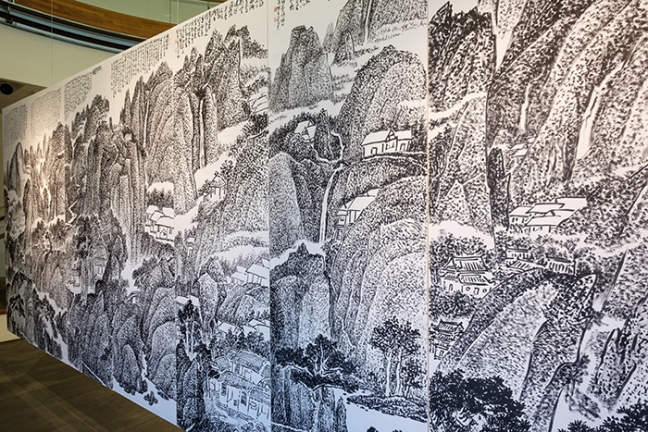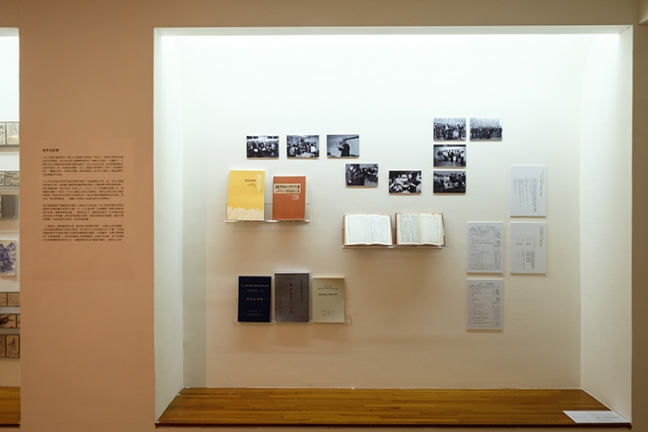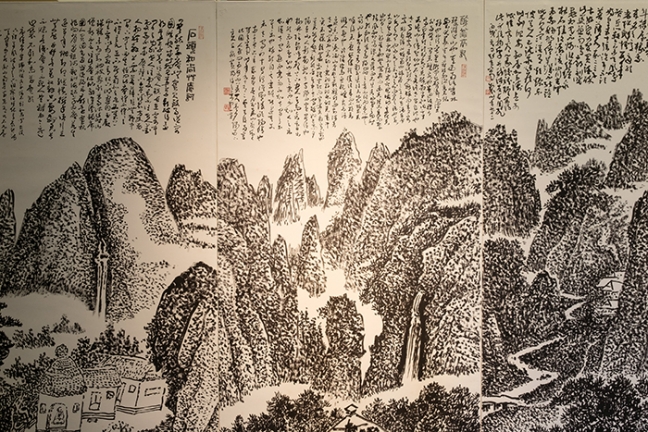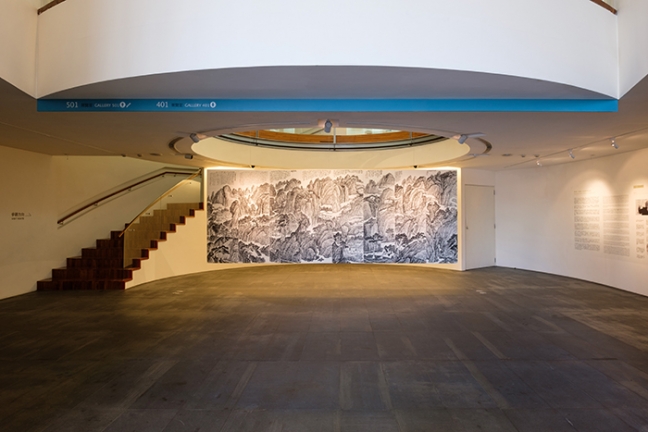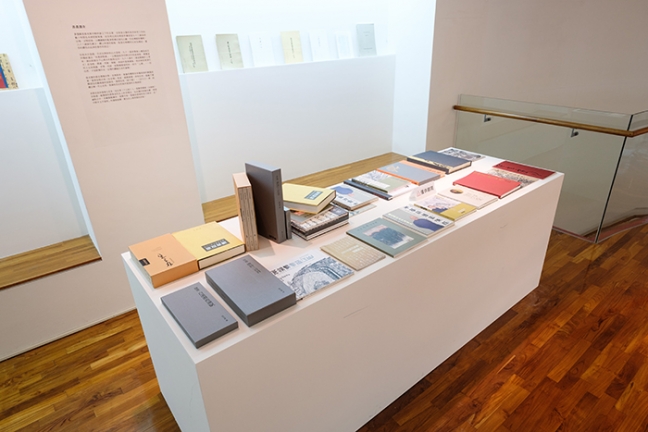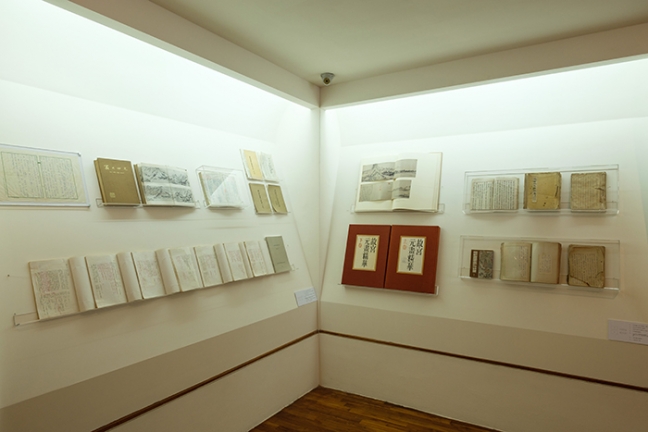The Literature and the Art Practice of Chang Kuang-Bin
2016.09.30~2016.12.11
09:00 - 17:00
【INTRODUCTION】 CHANG Kuang-Bin (1915-2016) was a Chinese style calligrapher, painter and scholar. Chang was born in Da county (known today as Dachua district), Sichuan China. He graduated from the National College of Fine Arts (known today as China Academy of Art) in 1945, where he was taught and influenced by some of the greatest calligraphers, painters and art historians of contemporary China, namely FU Bao-Shi and LI Ke-Ran. His academic years paved his life time dedication to researching, calligraphy and painting. Chang came to Taiwan in 1948 and served in the Navy for two decades before joining the National Palace Museum at the age of 55, he worked in the Department of Calligraphy and Painting and focused on Yuan style related researches. Although he made a late entrance onto the stage of formal calligraphy and painting, his outstanding performance was highly praised by all, especially in the academic circle. Chang was devoted to promote the art and practice of calligraphy, although he never formed a school of style, his devotion in continuing the fine tradition of writing and painting in Chinese styles has influenced people in Taiwan, China and Hong Kong. His unparalleled knowledge of Yuan art history sparked countless brilliant publications including《The four masters of Yuan dynasty (元四大家)》,《Essential Yuan paintings》and《Study and essays on Yuan style calligraphy and painting (元朝書畫史研究論集)》. Chang also solved the three-and-half century mystery of the Master Wuyong scroll – the authenticity of the second half of Huang Gongwang (1269–1354)’s master piece Dwelling in the Fuchun Mountains– and was considered as the walking encyclopedia of Yuan style. After retirement, he concentrated on painting and developed his personal style, which was a blend of the marrow of preceding art styles and Chang’s originality. At 83, he coined a new technique Jiāo mò san dian cùn (焦墨散點皴), instead of overlapping, glazing and using other ink colors to paint in brush strokes, the technique required painting in beads. He combined Cursive script with this technique to compose an epic piece . At 91, he elevated the technique to another level and created Jiāo mò san dian cùn (焦墨散點皴), beads were connected into lines that portrayed abstractions of subjectivity and echoed with the landscape as a subject, such technique extended the horizon of Chinese style painting. Chang’s Seal script and Clerical script contained both subtlety and power, his craftsmanship was refined by time and defined by his wisdom. Chang fused his unique interpretation and insights on calligraphy and wrote《History of Chinese Calligraphy》, a classic text in the calligraphy circle which covers origins, developments and examples of the art. In order to promote writing and reading Cursive styles, he wrote the〈Tips for writing Cursive style〉to summarize the principles for easy understanding. His contribution toward teaching calligraphy in Taiwan is second to none after YU Youren (1879-1964, Cursive style calligrapher) had passed away. Chang was 95 years old when he received both National Award for Arts and National Cultural Award in 2010, he continued to push his creative boundary and practiced daily. He shared his knowledge and generously gave to the research, education and promotion of traditional calligraphy and painting. Over 15 years, Chang donated $10 millions to TNUA’s School of Fine Arts. He left all savings and real estate to the National Palace Museum to fund research and other needs. Chang’s life time philosophy
stay calm and relaxed”- which he encouraged others to live by as well – faithfully reflected his simplistic way of living. In 2015, he received the Order of Brilliant Star (Class II) to honor his exceptional contribution toward arts and culture. All his life, in every single role he had played; a teacher, an artist and an advocate, he worked hard and kept true to himself. His eternal dedication toward calligraphy and painting, gentle and humble attitudes, and his outstanding achievement all resonate with his noble character. Chang passed away on 19 May 2016 at the age of 102. His manuscripts and documentations relating to the《The four masters of Yuan dynasty 》were donated to Kuandu Museum of Fine Arts. The General Association of Chinese Culture (GACC), sponsor of the Artists of Our Time project and Cross Strait Chinese Character Art Festival, is in collaboration with Kuandu Museum of Fine Arts to organize The Literature and the Art Practice of Chang Kuang-Bin. This exhibition is in memory of Chang –a selfless, kind and modest man, whose life time dedication to research, creation, teaching and advocacy of calligraphy and painting, as well as his artistic originality and influence on others will shine through the collection of 50 years of his manuscripts, research notes and other documents. Audience can also gain insight to his attitude to art creations - what may come depends on the creator himself, so just go with the flow. GACC is currently working on a number of projects, including digitizing〈Tips for writing Cursive style〉to enhance its educational value via interactive learning, and produce animation clips for the Chinese Linuipedia website to advocate Cursive style calligraphy and appreciation of exquisiteness in traditional Chinese characters. Kuandu Museum of Fine Arts will establish a digital archive to aid study and share his knowledge and works with the public. Organizers: Coordinator: Media Partners: Sponsor:
stay calm and relaxed”- which he encouraged others to live by as well – faithfully reflected his simplistic way of living. In 2015, he received the Order of Brilliant Star (Class II) to honor his exceptional contribution toward arts and culture. All his life, in every single role he had played; a teacher, an artist and an advocate, he worked hard and kept true to himself. His eternal dedication toward calligraphy and painting, gentle and humble attitudes, and his outstanding achievement all resonate with his noble character. Chang passed away on 19 May 2016 at the age of 102. His manuscripts and documentations relating to the《The four masters of Yuan dynasty 》were donated to Kuandu Museum of Fine Arts. The General Association of Chinese Culture (GACC), sponsor of the Artists of Our Time project and Cross Strait Chinese Character Art Festival, is in collaboration with Kuandu Museum of Fine Arts to organize The Literature and the Art Practice of Chang Kuang-Bin. This exhibition is in memory of Chang –a selfless, kind and modest man, whose life time dedication to research, creation, teaching and advocacy of calligraphy and painting, as well as his artistic originality and influence on others will shine through the collection of 50 years of his manuscripts, research notes and other documents. Audience can also gain insight to his attitude to art creations - what may come depends on the creator himself, so just go with the flow. GACC is currently working on a number of projects, including digitizing〈Tips for writing Cursive style〉to enhance its educational value via interactive learning, and produce animation clips for the Chinese Linuipedia website to advocate Cursive style calligraphy and appreciation of exquisiteness in traditional Chinese characters. Kuandu Museum of Fine Arts will establish a digital archive to aid study and share his knowledge and works with the public. Organizers: Coordinator: Media Partners: Sponsor:
【INTRODUCTION】 CHANG Kuang-Bin (1915-2016) was a Chinese style calligrapher, painter and scholar. Chang was born in Da county (known today as Dachua district), Sichuan China. He graduated from the National College of Fine Arts (known today as China Academy of Art) in 1945, where he was taught and influenced by some of the greatest calligraphers, painters and art historians of contemporary China, namely FU Bao-Shi and LI Ke-Ran. His academic years paved his life time dedication to researching, calligraphy and painting. Chang came to Taiwan in 1948 and served in the Navy for two decades before joining the National Palace Museum at the age of 55, he worked in the Department of Calligraphy and Painting and focused on Yuan style related researches. Although he made a late entrance onto the stage of formal calligraphy and painting, his outstanding performance was highly praised by all, especially in the academic circle. Chang was devoted to promote the art and practice of calligraphy, although he never formed a school of style, his devotion in continuing the fine tradition of writing and painting in Chinese styles has influenced people in Taiwan, China and Hong Kong. His unparalleled knowledge of Yuan art history sparked countless brilliant publications including《The four masters of Yuan dynasty (元四大家)》,《Essential Yuan paintings》and《Study and essays on Yuan style calligraphy and painting (元朝書畫史研究論集)》. Chang also solved the three-and-half century mystery of the Master Wuyong scroll – the authenticity of the second half of Huang Gongwang (1269–1354)’s master piece Dwelling in the Fuchun Mountains– and was considered as the walking encyclopedia of Yuan style. After retirement, he concentrated on painting and developed his personal style, which was a blend of the marrow of preceding art styles and Chang’s originality. At 83, he coined a new technique Jiāo mò san dian cùn (焦墨散點皴), instead of overlapping, glazing and using other ink colors to paint in brush strokes, the technique required painting in beads. He combined Cursive script with this technique to compose an epic piece . At 91, he elevated the technique to another level and created Jiāo mò san dian cùn (焦墨散點皴), beads were connected into lines that portrayed abstractions of subjectivity and echoed with the landscape as a subject, such technique extended the horizon of Chinese style painting. Chang’s Seal script and Clerical script contained both subtlety and power, his craftsmanship was refined by time and defined by his wisdom. Chang fused his unique interpretation and insights on calligraphy and wrote《History of Chinese Calligraphy》, a classic text in the calligraphy circle which covers origins, developments and examples of the art. In order to promote writing and reading Cursive styles, he wrote the〈Tips for writing Cursive style〉to summarize the principles for easy understanding. His contribution toward teaching calligraphy in Taiwan is second to none after YU Youren (1879-1964, Cursive style calligrapher) had passed away. Chang was 95 years old when he received both National Award for Arts and National Cultural Award in 2010, he continued to push his creative boundary and practiced daily. He shared his knowledge and generously gave to the research, education and promotion of traditional calligraphy and painting. Over 15 years, Chang donated $10 millions to TNUA’s School of Fine Arts. He left all savings and real estate to the National Palace Museum to fund research and other needs. Chang’s life time philosophy
stay calm and relaxed”- which he encouraged others to live by as well – faithfully reflected his simplistic way of living. In 2015, he received the Order of Brilliant Star (Class II) to honor his exceptional contribution toward arts and culture. All his life, in every single role he had played; a teacher, an artist and an advocate, he worked hard and kept true to himself. His eternal dedication toward calligraphy and painting, gentle and humble attitudes, and his outstanding achievement all resonate with his noble character. Chang passed away on 19 May 2016 at the age of 102. His manuscripts and documentations relating to the《The four masters of Yuan dynasty 》were donated to Kuandu Museum of Fine Arts. The General Association of Chinese Culture (GACC), sponsor of the Artists of Our Time project and Cross Strait Chinese Character Art Festival, is in collaboration with Kuandu Museum of Fine Arts to organize The Literature and the Art Practice of Chang Kuang-Bin. This exhibition is in memory of Chang –a selfless, kind and modest man, whose life time dedication to research, creation, teaching and advocacy of calligraphy and painting, as well as his artistic originality and influence on others will shine through the collection of 50 years of his manuscripts, research notes and other documents. Audience can also gain insight to his attitude to art creations - what may come depends on the creator himself, so just go with the flow. GACC is currently working on a number of projects, including digitizing〈Tips for writing Cursive style〉to enhance its educational value via interactive learning, and produce animation clips for the Chinese Linuipedia website to advocate Cursive style calligraphy and appreciation of exquisiteness in traditional Chinese characters. Kuandu Museum of Fine Arts will establish a digital archive to aid study and share his knowledge and works with the public. Organizers: Coordinator: Media Partners: Sponsor:
stay calm and relaxed”- which he encouraged others to live by as well – faithfully reflected his simplistic way of living. In 2015, he received the Order of Brilliant Star (Class II) to honor his exceptional contribution toward arts and culture. All his life, in every single role he had played; a teacher, an artist and an advocate, he worked hard and kept true to himself. His eternal dedication toward calligraphy and painting, gentle and humble attitudes, and his outstanding achievement all resonate with his noble character. Chang passed away on 19 May 2016 at the age of 102. His manuscripts and documentations relating to the《The four masters of Yuan dynasty 》were donated to Kuandu Museum of Fine Arts. The General Association of Chinese Culture (GACC), sponsor of the Artists of Our Time project and Cross Strait Chinese Character Art Festival, is in collaboration with Kuandu Museum of Fine Arts to organize The Literature and the Art Practice of Chang Kuang-Bin. This exhibition is in memory of Chang –a selfless, kind and modest man, whose life time dedication to research, creation, teaching and advocacy of calligraphy and painting, as well as his artistic originality and influence on others will shine through the collection of 50 years of his manuscripts, research notes and other documents. Audience can also gain insight to his attitude to art creations - what may come depends on the creator himself, so just go with the flow. GACC is currently working on a number of projects, including digitizing〈Tips for writing Cursive style〉to enhance its educational value via interactive learning, and produce animation clips for the Chinese Linuipedia website to advocate Cursive style calligraphy and appreciation of exquisiteness in traditional Chinese characters. Kuandu Museum of Fine Arts will establish a digital archive to aid study and share his knowledge and works with the public. Organizers: Coordinator: Media Partners: Sponsor:
